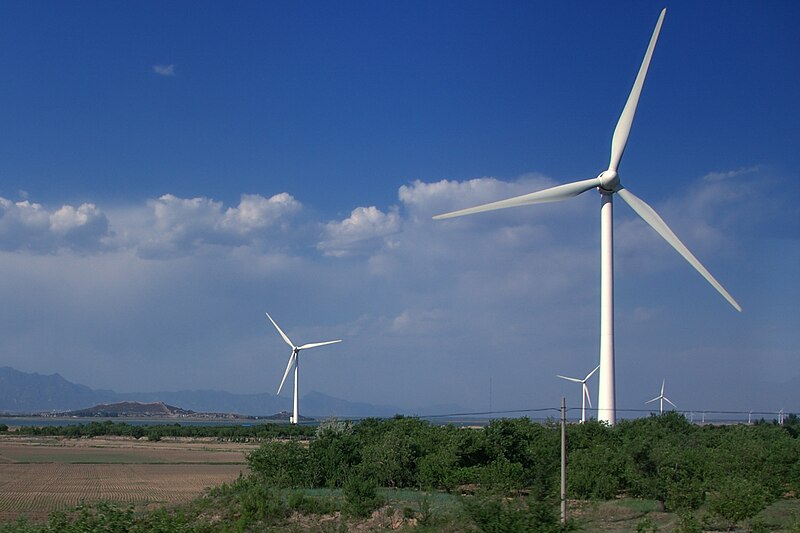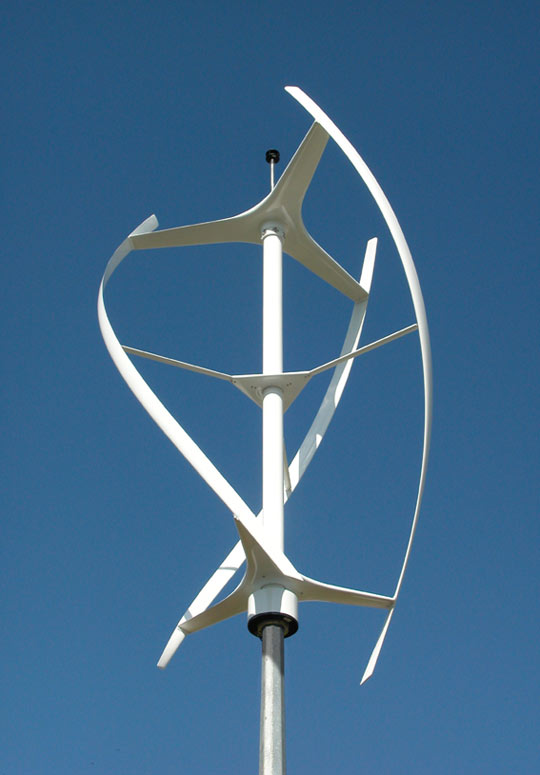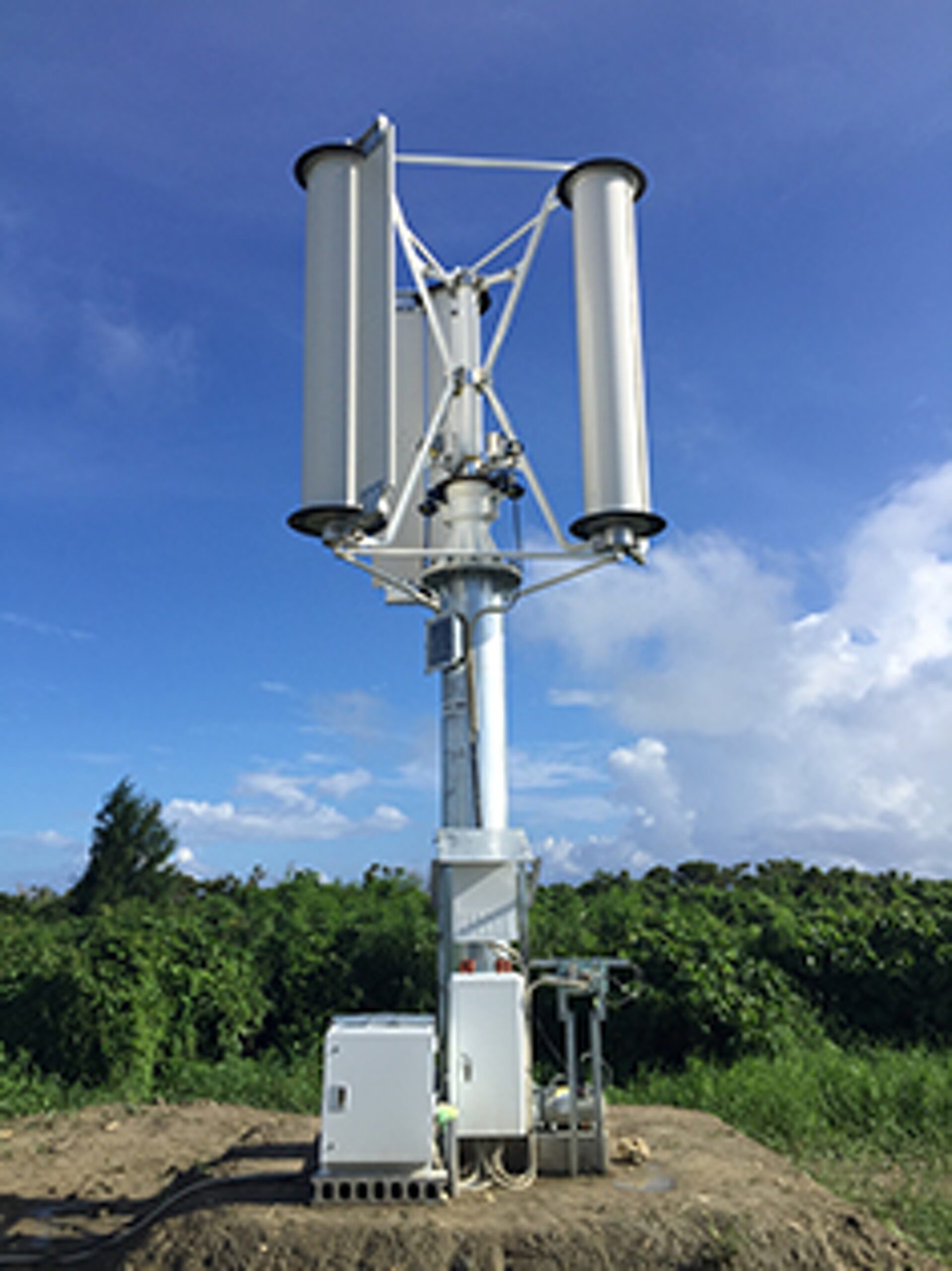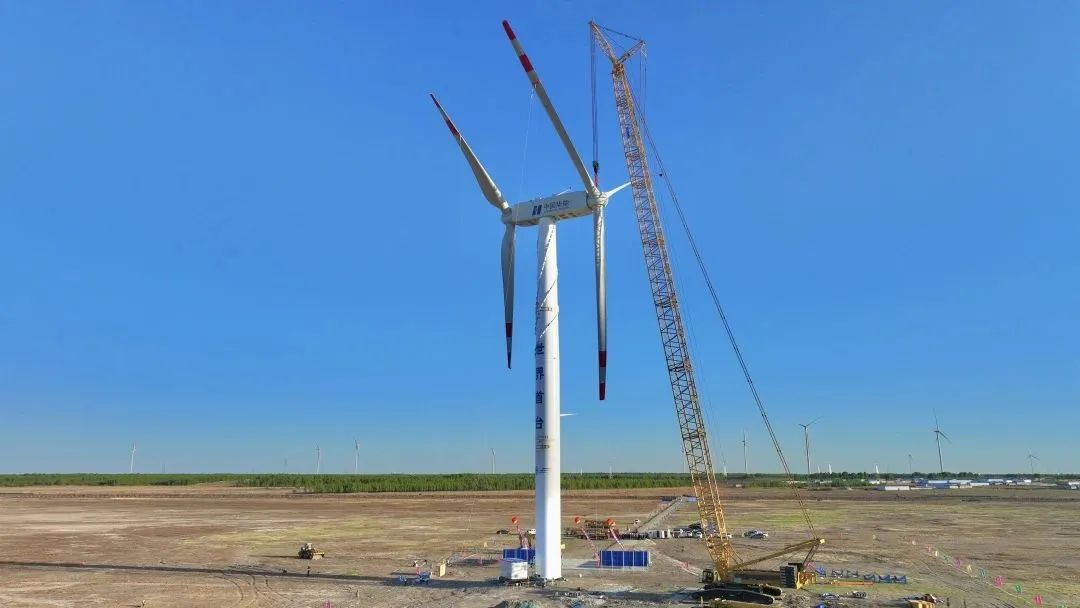A wind turbine is a component that converts the mechanical energy of the rotor (obtained from the wind) into electrical energy. The generator has the same structure as an electric motor. Although there are many different types of wind turbines, they can be summarized into two categories ① Horizontal-axis wind turbines, in which the rotational axis of the wind turbine is parallel to the wind direction ② Vertical-axis wind turbines, in which the rotational axis of the wind turbine is perpendicular to the ground or to the direction of the air flow.
Horizontal axis wind turbines
Horizontal axis wind turbines are divided into two categories: lift type and drag type. Lift-type wind turbines rotate at a fast speed, while drag-type rotate at a slow speed. For wind power generation, lift-type horizontal axis wind turbines are mostly used. Most horizontal-axis wind turbines have a wind countermeasure, which can rotate with the change of wind direction. For small wind turbines, this wind countermeasure uses a rudder, while for large wind turbines, wind sensing elements are utilized as well as a drive mechanism consisting of a servomotor. Wind turbines with the wind wheel in front of the tower are called upwind wind turbines, while those with the wind wheel behind the tower become downwind wind turbines. Horizontal axis wind turbines have many styles, some have wind turbines with reversed blades, some install multiple wind turbines on one tower to reduce the cost of the tower under the condition of a certain output power, and others have horizontal axis wind turbines that produce vortices around the wind turbine to concentrate the airflow and increase the speed of the airflow.

Vertical Axis Wind Turbine
Vertical axis wind turbines do not need to wind when the wind direction changes, at this point relative to the horizontal axis wind turbines is a major advantage, it not only makes the structural design is simplified, but also reduces the gyroscopic force of the wind turbine to the wind. There are several types of vertical axis wind turbines that utilize drag to rotate, including wind wheels made from flat plates and quilts, which are pure drag devices; S-shaped windmills, which have partial lift, but are still primarily drag devices. These devices have a large starting torque, but have a low tip-speed ratio and provide a low power output for a given size, weight and cost of the wind turbine.

Doubly-fed wind turbines
With the development of power electronics technology, doubly-fed induction generators (Double-Fed Induction Generator) are increasingly used in wind power generation. This technology is not overly dependent on the capacity of the battery, but from the excitation system, the excitation current to be appropriate control, so as to achieve the output of a constant frequency power. Doubly-fed induction generators are similar to asynchronous generators in structure, but in excitation doubly-fed generators use AC excitation. We know that a pulsating magnetic potential can be decomposed into two rotating magnetic potentials in opposite directions, and the proper arrangement of three-phase windings can make the effect of one of the magnetic potentials dissipate, so that a rotating magnetic potential in space is obtained, which is equivalent to the rotor with DC excitation in a synchronous generator. The advantage of the doubly-fed generator lies in the fact that the frequency of the AC excitation is adjustable, which means that the frequency of the rotating excitation magnetic potential is adjustable. This means that the frequency of the rotating excitation magnetic potential is adjustable. Thus, when the rotational speed of the prime mover is not constant, the frequency of the excitation current can be adjusted appropriately to meet the purpose of outputting constant-frequency electric power. Since the capacity of power electronic components is getting bigger and bigger, the regulation ability of the excitation system of doubly-fed generator sets is getting stronger and stronger, which makes it possible to increase the stand-alone capacity of doubly-fed machines. Although, part of the theory is still in the process of improvement, but the wide application of doubly-fed reaction generator this trend will become more and more obvious. Wind power, not the national conditions of the domestic wind power plants have been launched most of the image of the project. Miao Wei, vice minister of the Ministry of Industry and Information Technology, recently made a shocking statement, he believes that China's wind and sand with the existence of wind power equipment by the wind and sand wear and tear, too many wind power project is not China's national conditions. Miao Wei said, foreign wind places without sand, such as ocean wind. Miao Wei said: China is a windy place there is sand, wind and sand on the wind power generation equipment wear and tear is very strong. Now wind power generation fan should be 20 years of life, but if there is wind and sand erosion life can not reach 20 years.

Darrieu type wind turbine wind turbine
It was invented by G.J.M Darrieux of France in the 1830s. In the 1970s, the National Institute of Science in Canada conducted extensive research on it, and it is now a major contender for the horizontal axis wind turbine. The Darrieux-type wind turbine is a lifting device with an airfoil profile of curved blades, which has a low starting torque but can have a high tip-speed ratio and a high power output for a given turbine weight and cost. Nowadays there are various Darrieux type wind turbines such as Φ, Δ, Y and H type. These wind turbines can be designed with single, double, triple or multiple blades.
Magnus Effect Wind Turbine Wind Turbine
Magnus effect wind turbine, consists of a spinning cylinder which, when operating in an air stream, generates a moving force due to the Magnus effect, the magnitude of which is proportional to the wind speed. Some vertical axis wind wheel using pipe or vortex generator tower, through the casing or diffuser to make the horizontal airflow into vertical airflow, in order to increase the speed, occasional write also use solar energy or burning some kind of fuel, is the horizontal airflow into the vertical direction of the airflow.

Magnus effect wind turbine wind turbine
The Magnus effect wind turbine, consisting of a spinning cylinder, produces a moving force due to the Magnus effect when it operates in an air stream, the magnitude of which is proportional to the wind speed. Some vertical axis wind wheel using pipe or vortex generator tower, through the casing or diffuser to make the horizontal airflow into a vertical airflow, in order to increase the speed, occasional writing also use solar energy or burning some kind of fuel, is the horizontal airflow into the vertical direction of the airflow.

Radial Twin Wheel Effect Wind Turbine Wind Turbine
The Runoff Twin Wheel Effect or Twin Wheel Effect is a new type of wind energy conversion. First of all, it is a two-wheel structure, relative to the horizontal axial fan, it is a radial type, with the existing vertical axis fan are laid along the long axis of the paddle, the direct use of the wind thrust rotary work, a single wheel vertical axis wind turbine due to the shaft on both sides of the paddle at the same time to accept the wind and the torque of the opposite torque, offset each other, the output torque is not large. Designed for the dual-wheel structure and installed close to the synchronous operation, the original vertical axis torque output on the paddle hydrodynamic shape of the dependence on the use of the vortex force between the two wheels and then changed to the use of rotation between the use of vortex force, the two wheels lend each other a hand to push each other; and blowing to the two wheels between the reversal of the wind flow can be mutually blocked, and then turn in turn will be allocated in the outside of the two wheels, so that the two wheels to get the outside of the superposition of the wind flow, so that the Double wheel of the outer edge of the line speed can be higher than the wind speed, double wheel structure of this mutual assistance, the active use of wind characteristics of the “double wheel effect”. Compared with some single-wheeled structure wind turbines, which adopt passive designs to reduce the impeller rotary reset resistance such as the external shielding method and movable pitch torque, the invention embodies the feature of actively utilizing wind power. Therefore, this invention not only has a practical role in promoting the research and development of wind power utilization, but also has a new significance in terms of hydrodynamics. It opens up a new space for the development of wind energy, is an invention with a basic nature, this double-wheeled fan has a simple design, easy to manufacture and process, lower number of revolutions, the center of gravity down, good safety, low operating costs, easy maintenance, no noise pollution and other obvious features, can be widely popularized and promoted to adapt to China's energy saving and emission reduction needs, great market prospects.

बोलैंड नवीकरणीय ऊर्जा कं, लिमिटेड एक एकीकृत नई ऊर्जा ऊर्जा कंपनी के रूप में, आपको उच्च गुणवत्ता वाली एकीकृत पवन ऊर्जा, सौर ऊर्जा और ऊर्जा भंडारण प्रणाली समाधान प्रदान करती है। बोलैंड अब सीआरआरसी की सहायक कंपनी है, और सीआरआरसी की पवन ऊर्जा के विदेशी विस्तार के लिए जिम्मेदार है। और सौर ऊर्जा व्यवसाय। हमारे पास अपेक्षाकृत पूर्ण आंतरिक आपूर्ति श्रृंखला, सेवा नेटवर्क और उत्कृष्ट उत्पाद गुणवत्ता और प्रौद्योगिकी है।
बोलैंड पावर प्लांट ईपीसी, पावर प्लांट निवेश और अधिग्रहण प्रदान करें।
कृपया बेझिझक हमसे संपर्क करें यदि आपको किसी तकनीकी सहायता की आवश्यकता है। हमारे सहयोग के लिए चीयर्स!
मेरा ईमेल:marketing@boland-hydroturbine.com
डब्ल्यूए:+8613923745989


